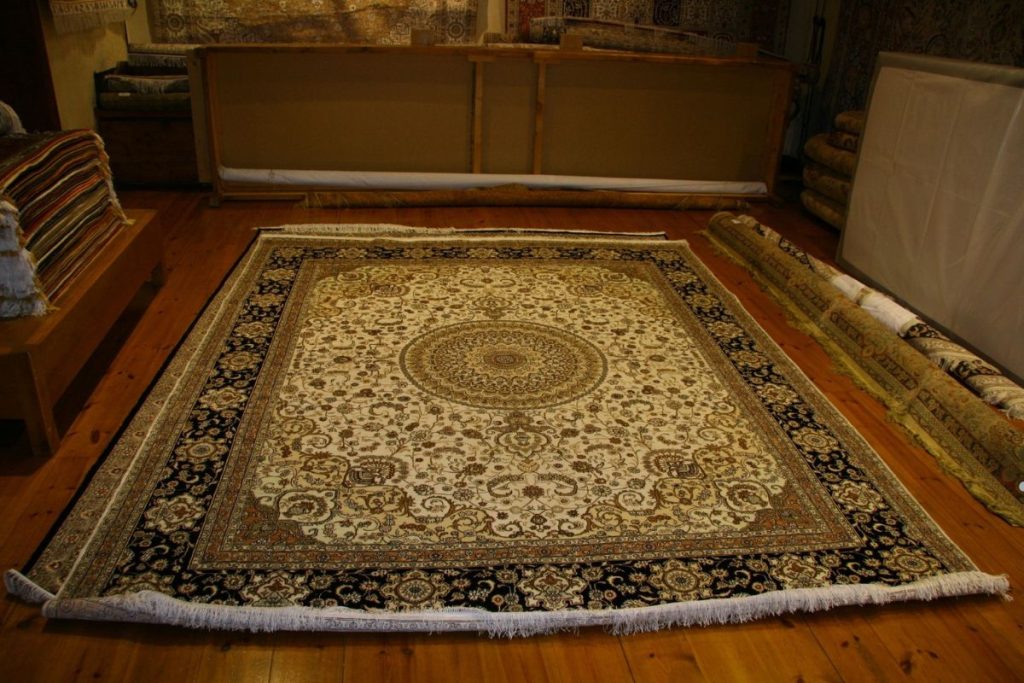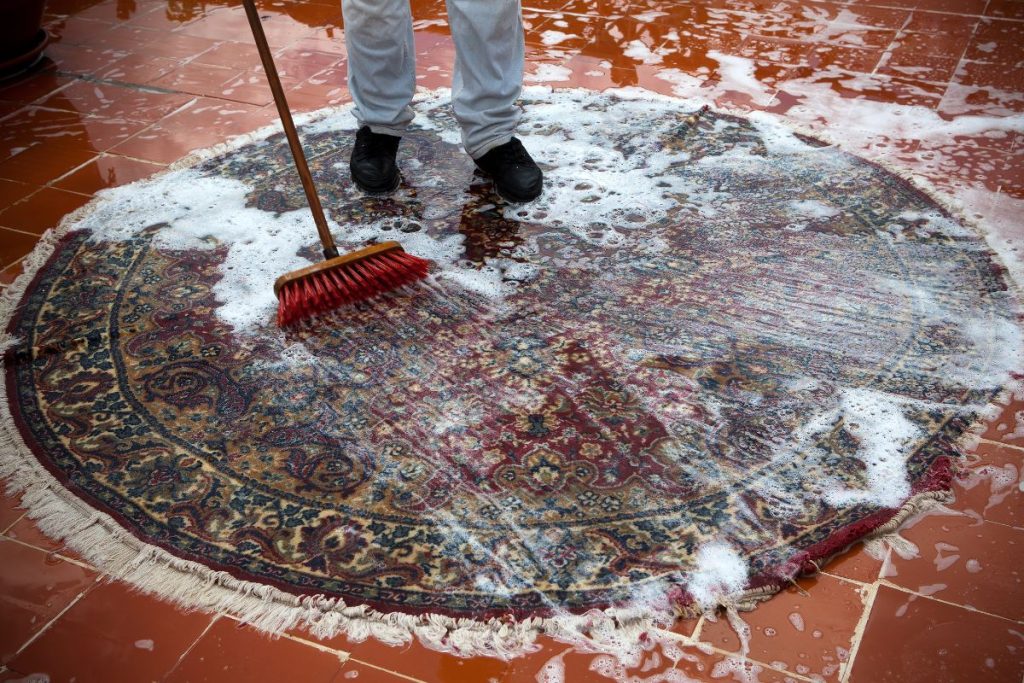
Washing a rug might seem like a simple task, but there’s a bit more to it than just soap and water—especially in Honolulu. Between the humidity and unique climate, you’ll want to make sure you’re doing it the right way to keep your rug looking its best. Whether it’s an antique heirloom or a sturdy outdoor rug, knowing how to wash a rug in Honolulu can make all the difference.
Key Takeaways
- Different rug materials need different cleaning methods, so always check what your rug is made of.
- Inspect your rug for damage or stains before you start washing it.
- Set up a proper cleaning space and use the right tools for the job.
- Drying rugs in Honolulu’s humid weather requires good airflow to prevent mold.
- For tough jobs, don’t hesitate to call a professional rug cleaner.
Understanding Rug Types for Effective Cleaning
Identifying Common Rug Materials
Rugs come in all kinds of materials, and knowing what yours is made of is step one to cleaning it right. Common materials include wool, cotton, synthetic fibers like nylon or polyester, and even silk. Each material has different cleaning needs, so don’t skip this step. For example:
- Wool rugs are durable but can shrink if soaked too long.
- Cotton rugs are lightweight and easier to clean but can fade.
- Synthetic rugs handle moisture well but might trap dirt over time.
- Silk rugs? They’re gorgeous but super delicate—hand-washing only.
Why Rug Type Matters in Cleaning
Not all rugs are created equal, and treating them the same could ruin them. A wool rug, for instance, can handle a gentle shampoo, but a silk rug? That’s a no-go. Synthetic rugs might seem bulletproof, but using a harsh cleaner can break down the fibers. Just like using the right repair methods for specific appliances, matching the cleaning method to the rug type means you’ll keep it looking fresh without causing damage. Learn more with our Commercial Appliance Repair Services.
Special Considerations for Antique Rugs
Antique rugs are like family heirlooms—they need extra TLC. Before washing, check for weak spots or frayed edges. Avoid heavy scrubbing or soaking, as these can cause the fibers to break down. Instead, opt for gentle vacuuming and spot cleaning. If you’re unsure, it’s best to consult a pro. These rugs often have natural dyes that can bleed, so test a small area first to avoid any surprises. For further care tips, consider exploring small appliance repair services for professional assistance with your cleaning tools.
Knowing your rug’s material and age isn’t just helpful—it’s the difference between a clean rug and a damaged one. Take the time to figure it out, and you won’t regret it.

Preparing Your Rug for Washing
Inspecting for Stains and Damage
Before you even think about washing your rug, take a close look at it. Check for stains, frayed edges, or any signs of wear and tear. Spotting damage early can save you a lot of trouble later. If you find any issues like loose threads or small tears, consider fixing them before washing so they don’t get worse. And don’t forget to flip the rug over! Sometimes the underside hides damage you might miss.
Choosing the Right Cleaning Products
Picking the right cleaning solution is super important. For most rugs, a mild detergent works well, but you might need something special if your rug is made of wool or silk. Always check the care tag on your rug—it’s like a cheat sheet for cleaning. And if you’re unsure, test your cleaner on a small, hidden area first. Better safe than sorry!
Vacuuming and Dusting Before Washing
This step might seem obvious, but it’s a biggie. Vacuum your rug thoroughly to remove dirt, hair, and debris. Use a handheld vacuum for the corners and edges where dust loves to hide. If your rug is small enough, give it a good shake outside to loosen up trapped dirt. For extra dusty rugs, a gentle beat with a broomstick can work wonders. Prepping your rug like this makes the actual washing way more effective.
Step-by-Step Guide to Washing Your Rug at Home
Setting Up a Cleaning Area
Before you even think about washing, you’ve got to pick the right spot. Ideally, you’ll want an outdoor space like a patio or driveway, but if that’s not an option, a garage floor works too. Lay down a plastic tarp or waterproof mat to protect the surface underneath. Make sure the area has good drainage because things can get messy fast. Keep a bucket, scrub brushes, and cleaning products nearby so you’re not scrambling mid-wash.
Hand-Washing Techniques for Delicate Rugs
If your rug is delicate—like wool or silk—you’ll want to skip the heavy-duty methods. Start by mixing a mild detergent with cool water in a bucket. Dip a soft-bristled brush or sponge into the soapy water and gently scrub the rug in small sections. Be extra cautious around the edges and any intricate patterns. Once you’re done, rinse the rug thoroughly with clean water, but don’t drench it. Patience is key here; you don’t want to rush and risk damaging the fibers.
Using a Pressure Washer for Outdoor Rugs
For sturdier rugs, like those made for outdoor use, a pressure washer can be a lifesaver. Lay the rug flat on your cleaning area and hold the washer nozzle about 12 inches away to avoid tearing the material. Work in even, horizontal strokes, starting from one end and moving to the other. If there are stubborn stains, you can go over them a couple of times, but don’t overdo it. After washing, hang the rug over a sturdy railing or clothesline to let the excess water drip off before drying it completely.
Washing a rug at home doesn’t have to be overwhelming. With the right setup and techniques, you can save money and keep your rug looking great without professional help.
Drying Your Rug Properly in Honolulu’s Climate
The Importance of Proper Airflow
Drying a rug in Honolulu can be tricky due to the island’s humid climate. Proper airflow is key to ensuring your rug dries evenly and doesn’t trap moisture. Using heating and air conditioning services to maintain optimal indoor airflow and humidity levels can make a big difference when drying items like rugs. If you’re drying your rug indoors, place it near a fan or air conditioner to help circulate air and speed up the drying process. For more on ensuring proper air circulation, visit heating and air conditioning services
Mold and mildew can sneak up on you if your rug stays damp for too long. To prevent this, make sure to:
- Dry your rug as quickly as possible after washing.
- Check for damp spots by touching the rug or using a moisture meter.
- Flip the rug periodically to ensure both sides dry thoroughly.
If you notice a musty smell, that’s a sign you might need to rewash and dry it more carefully.
Tips for Faster Drying in Humid Weather
Honolulu’s humidity can make drying rugs a challenge, but there are ways to speed things up:
- Use a dehumidifier in the room where the rug is drying.
- Place the rug on a drying rack or hang it over a sturdy clothesline.
- Take advantage of sunny days, but avoid direct sunlight for too long to protect the rug’s colors.
Honolulu’s tropical weather is beautiful, but it can make rug drying a patience game. Stay proactive, and your rug will be fresh and ready in no time.

When to Seek Professional Rug Cleaning Services
Signs Your Rug Needs Expert Care
Sometimes, no matter how much effort you put into cleaning, your rug just doesn’t look or feel right. Here are a few signs it’s time to call in the pros:
- Stubborn stains that won’t budge, even after multiple attempts.
- Persistent odors, especially from pet accidents or spills.
- Noticeable wear and tear, like fraying edges or loose threads.
- Discoloration or fading that regular cleaning can’t fix.
If you’ve noticed any of these, it’s probably better to let a professional handle it rather than risk damaging your rug further.
Benefits of Professional Cleaning in Honolulu
Professional cleaning isn’t just about convenience. It comes with a bunch of perks that make it worth considering:
- Deep cleaning: Experts have the tools and techniques to remove dirt and allergens buried deep in the fibers.
- Specialized care: They know how to handle delicate or antique rugs without causing damage.
- Time-saving: Instead of spending hours scrubbing, you can focus on other things while they do the hard work.
Plus, in a humid place like Honolulu, professionals can ensure your rug dries properly, reducing the risk of mold or mildew.
How to Choose a Reliable Rug Cleaning Service
Not all cleaning services are created equal, so it’s important to pick one that fits your needs. Here’s what to look for:
- Experience: Companies with years of experience are more likely to handle your rug with care.
- Certifications: Check if they’re certified by organizations like the IICRC (Institute of Inspection Cleaning and Restoration Certification).
- Reviews: Look for customer feedback to see if others were satisfied with their service.
- Services offered: Make sure they specialize in the type of rug you need cleaned.
- Pricing: While you don’t want to skimp, compare prices to ensure you’re getting fair value.
If you’re considering professional annual rug cleaning, it’s worth noting that it can help maintain indoor air quality and extend the lifespan of your rugs. Trust experienced cleaners for optimal results.
Taking the time to find the right service can make all the difference in how your rug looks and feels after cleaning.
Eco-Friendly Rug Cleaning Options in Honolulu
Using Natural Cleaning Solutions
When it comes to keeping your rugs clean and green, natural cleaning solutions are a fantastic option. Switching to plant-based cleaners can reduce exposure to harsh chemicals, making it safer for your family and pets. Ingredients like vinegar, baking soda, and lemon juice can work wonders on stains and odors. For more tips on natural cleaning methods, check out this guide on eco-friendly cleaning solutions. Here’s a simple recipe for a DIY rug cleaner:
- Mix 1 cup of white vinegar with 2 cups of warm water.
- Add a tablespoon of baking soda and a few drops of essential oil for a fresh scent.
- Use a spray bottle to apply the solution and blot with a clean cloth.
This method is not only effective but also gentle on delicate fabrics.
Water Conservation Tips for Rug Washing
Honolulu’s warm climate can make water conservation a real priority. To minimize water waste while washing your rug, consider these tips:
- Pre-treat stains to avoid multiple washes.
- Use a bucket and sponge instead of a running hose.
- Opt for a low-flow hose nozzle if you must rinse outdoors.
By being mindful of water usage, you’re not only saving resources but also cutting down on your utility bills.
Local Eco-Friendly Cleaning Services
If DIY isn’t your thing or your rug needs extra care, Honolulu has some great eco-friendly cleaning services. For example, Aloha Chem Dry offers efficient, local, and eco-friendly carpet cleaning services. Their team uses environmentally safe products that are tough on dirt but kind to the planet. Plus, their professional approach ensures your rug looks refreshed without any damage.
Maintaining Your Rug After Washing
Regular Vacuuming and Spot Cleaning
Keeping your rug clean after washing is all about consistency. Regular vacuuming is essential for maintaining area rugs, especially in high-traffic areas. Aim to vacuum at least once a week to remove surface dirt and prevent debris from settling into the fibers. For small spills or stains, tackle them immediately with a gentle spot-cleaning solution. A quick response can save you from a bigger cleaning job later.
Protecting Your Rug from Sun Damage
Sunlight can be tough on rugs, especially if they’re exposed to direct rays daily. Over time, UV exposure can fade colors and weaken fibers. To protect your rug, consider placing curtains or blinds in rooms with strong sunlight. Alternatively, you can rotate your rug every few months to ensure even exposure, minimizing the risk of one side fading faster than the other. Call us for more expert tips!
Rotating Your Rug to Prevent Wear
Speaking of rotation, this is a simple yet effective way to extend the life of your rug. High-traffic areas like living rooms or hallways can cause uneven wear, leaving certain spots looking worn out. By rotating your rug every three to six months, you’ll distribute the foot traffic more evenly, keeping it looking fresh for longer.
Taking small, regular steps to care for your rug can make a big difference in its longevity and appearance. It’s all about building habits that protect your investment.
Wrapping It Up
So, there you have it. Washing a rug in Honolulu doesn’t have to be a big deal. With the right tools, a little patience, and some know-how, you can get your rug looking fresh and clean without breaking a sweat. Just remember to check the care label, use gentle cleaning products, and let it dry completely before putting it back in place. It’s not rocket science, but it does take a bit of effort. Give it a try, and you might even enjoy the process. Who knows? Your rug might thank you for it!
Frequently Asked Questions
What’s the best way to clean a delicate rug?
Hand washing is the safest method for delicate rugs. Use a gentle detergent and soft brush to avoid damage. Call us for expert care and assistance!
Can I use a pressure washer on my rug?
Yes, but only for sturdy outdoor rugs. Avoid using it on delicate or antique rugs as it can harm the fibers.
How do I dry a rug quickly in a humid place like Honolulu?
Make sure there’s good airflow by using fans or placing the rug in a breezy area. Avoid direct sunlight to prevent fading.
When should I call a professional for rug cleaning?
If your rug has stubborn stains, smells, or is an antique, it’s best to let a professional handle it.
Are there eco-friendly ways to clean rugs?
Yes, you can use natural cleaners like vinegar and baking soda. Also, try to conserve water during the cleaning process.
How often should I wash my rug?
It depends on use, but washing it once or twice a year is usually enough. Regular vacuuming helps keep it clean between washes. For further assistance, contact us!
